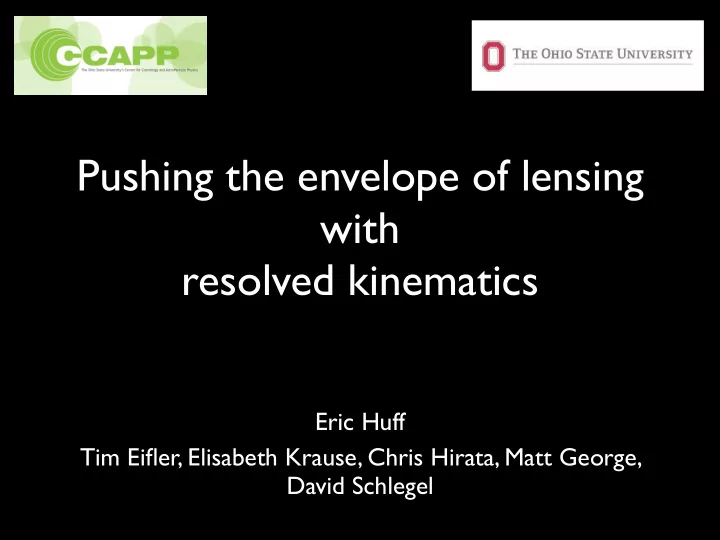

Pushing the envelope of lensing with resolved kinematics Eric Huff Tim Eifler, Elisabeth Krause, Chris Hirata, Matt George, David Schlegel
Kinematics break degeneracy between shape and shear image rotation curve face-on face-on, but sheared inclined, but not sheared
Shear changes the orientation of an ellipse γ × = 0 . 2 But shear has no solid-body rotation component.
Lensing mis-aligns the kinematic and photometric axes q int = 0 . 75 , γ + = 0 , γ × = 0 γ × = 0 . 2 60 60 2 2 45 45 30 30 1 1 (km/s) v LOS (km/s) 15 y (arcsec) y (arcsec) 15 0 0 0 0 − 15 − 15 v − 1 − 1 − 30 − 30 − 45 − 45 − 2 − 2 − 60 − 60 − 2 − 1 0 1 2 − 2 − 1 0 1 2 x (arcsec) x (arcsec)
Consider the Tully-Fisher relation. Schlegel (private comm.) Reyes et al 2011 Reyes et al 2011
With spectroscopy, the Tully-Fisher relation tells us the inclination angle. Red trendline: TF relation, which we treat as given log [sin(i)] Blue points: not corrected for inclination For a disk, sin(i) tells us what ellipticity we should measure in the absence of lensing.
Shear messes up the inclination correction. v obs = v TF sin( i ) + σ TF Tully-Fisher: ◆ 1 ✓ 2 e 2 For a disk: sin( i ) = 1 + e The effect of a shear: e 7! e + γ γ sin( i ) | γ = sin( i ) | γ =0 + p 2 e (1 + e ) 3
The reduction in shape noise can be very large… normal shape noise p e (1 + e ) 3 σ TF σ eff = 4 . 4 …For face-on disks, factors of 10.
A spectroscopic weak lensing measurement with slit spectroscopy γ × = 0 . 2 60 2 45 30 1 v LOS (km/s) y (arcsec) 15 0 0 − 15 − 1 − 30 − 45 − 2 − 60 − 2 − 1 0 1 2 x (arcsec)
A spectroscopic weak lensing measurement with slit spectroscopy γ × = 0 . 2 60 2 45 30 1 v LOS (km/s) y (arcsec) 15 0 0 − 15 − 1 − 30 − 45 − 2 − 60 − 2 − 1 0 1 2 x (arcsec) Less rotation along the major axis than TFR would predict
A spectroscopic weak lensing measurement with slit spectroscopy γ × = 0 . 2 60 2 45 30 1 v LOS (km/s) y (arcsec) 15 0 0 − 15 − 1 − 30 − 45 − 2 − 60 − 2 − 1 0 1 2 x (arcsec) More rotation along the minor axis than TFR would predict
Simulating the measurement: Slit Spectroscopy simple galsim-based simulation ———————- consistent with DES/BigBOSS estimates Keck-DEIMOS June 30, 2014
Simulating the measurement: Slit Spectroscopy extremely crude Fisher estimate: • 8m telescope shear (+) • 1000 s • Paranal sky, atm ———————- gain factor of ~30 measurement precision shear (x) over shapes alone
Simulating the measurement: fiber Spectroscopy shear (+) shear (x) (work ongoing)
For this level of per-galaxy shape noise: σ e Shape noise: ∝ √ n gal n gal ≈ 25 gal arcmin − 2 For LSST: σ e ≈ 0 . 2 For kinematic lensing, equivalent shape noise with: σ e ≈ 0 . 025 n gal ≈ . 25 gal arcmin − 2
n gal ≈ . 25 gal arcmin − 2 ∼ 10 3 deg 2 ⇒ 10 7 spectra = This is achievable with SuMIRe/PFS or DESI
None of the usual lensing systematics matter We’ll have spectra • Photo-z’s for every source galaxy • Intrinsic alignments • Shear measurement • PSF correction
None of the usual lensing systematics matter • Photo-z’s Intrinsic alignments don’t contribute • Intrinsic alignments (at ~leading order) to the kinematic • Shear measurement signal • PSF correction
None of the usual lensing systematics matter • Photo-z’s • Intrinsic alignments • Shear measurement Low ¯ n gal means we can • PSF correction target bright, resolved galaxies
Recommend
More recommend